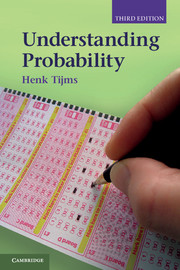Appendix: Counting methods and ex
Published online by Cambridge University Press: 05 August 2012
Summary
This appendix first gives some background material on counting methods. Many probability problems require counting techniques. In particular, these techniques are extremely useful for computing probabilities in a chance experiment in which all possible outcomes are equally likely. In such experiments, one needs effective methods to count the number of outcomes in any specific event. In counting problems, it is important to know whether the order in which the elements are counted is relevant or not. After the discussion on counting methods, the appendix summarizes a number of properties of the famous number e and the exponential function ex both playing an important role in probability.
Permutations
How many different ways can you arrange a number of different objects such as letters or numbers? For example, what is the number of different ways that the three letters A, B, and C can be arranged? By writing out all the possibilities ABC, ACB, BAC, BCA, CAB, and CBA, you can see that the total number is 6. This brute-force method of writing down all the possibilities and counting them is naturally not practical when the number of possibilities gets large, for example the number of different ways to arrange the 26 letters of the alphabet. You can also determine that the three letters A, B, and C can be written down in 6 different ways by reasoning as follows. For the first position, there are 3 available letters to choose from, for the second position there are 2 letters over to choose from, and only one letter for the third position.
- Type
- Chapter
- Information
- Understanding Probability , pp. 532 - 537Publisher: Cambridge University PressPrint publication year: 2012



